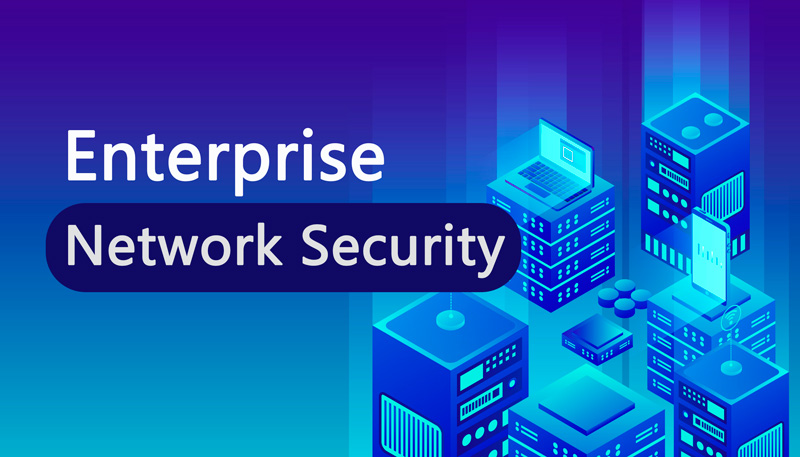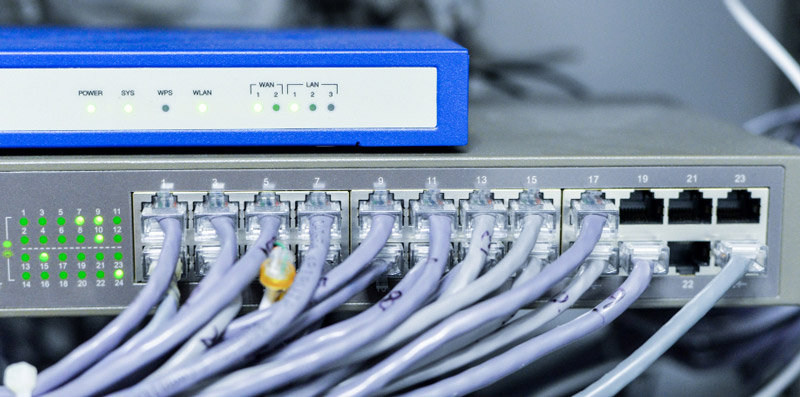Enterprise Network Security: Threats & Effective Practices
Enterprise network security is the utmost part of any organization. It safeguards the firms from many cyber threats, which tend to lead to devastating losses. With the proper protection, enterprises can avoid problems like potential financial losses, reputational damage, legal consequences, losing customer trust, and more.
Therefore, the importance of a robust security network must be considered. In today’s modern interconnected digital landscape, investing in the security of your enterprise is a necessary and strategic imperative for long-term business sustainability. Let’s find out more!

What Is Enterprise Network Security
Before delving, have a quick overview of 'what is enterprise network security!'
Enterprise network security includes the strategies and methods to secure a company's computer systems, data, and infrastructure against various online threats like unauthorized access, assaults, and data breaches. Multiple techniques protect sensitive information, like intrusion detection systems, firewalls, and encryption.
Key Components Of Enterprise Network
The following is the list of some fundamentals of an enterprise security network:
A. Network Connectivity Infrastructure
Network connectivity infrastructure refers to many vital components that aid communication in wired and wireless networks. In wired networks, the devices that are used to carry data efficiently are ethernet cables, routers, adapters, and switches. However, the elements that enable seamless communication in wireless networks are wireless access points, Wireless Network Interface Cards (NICs), adapters, routers, and repeaters.
B. Network Services Infrastructure
A network services infrastructure is a pivotal foundation for any organization that supports different operations. Database servers are used to manage the data storage. A DNS server helps to translate the domain names to IP addresses, and web servers facilitate the website hosting. Besides, there are more elements like an application server to execute application-specific tasks, file servers to store and share files, etc.
C. Network Communications Protocols
Network Communications Protocols are necessary for the adequate data flow between the network devices. TCP, called the Transmission Control Protocol, is used for consistent, orderly, and error-free data transmission. Besides, HTTPS, a secure HTTP extension, helps encrypt data transmission over the Internet using SSL/TLS.
D. Others
Several other elements play a crucial part as a component of the network. These endpoints include laptops, PCs, mobile devices, printers, and more. Moreover, security infrastructures like Firewalls and IDS/IPS systems are also there.
Ultimately, a secure enterprise network means to secure the fundamentals mentioned above. Every firm should focus on protecting its networks with these essential components.

Major Network Security Threats Faced By Organizations
Organizations can encounter various enterprise network security threats. It is good to stay aware of them and be prepared to resolve them if they occur. The following are some major ones:
1 Threats to Wireless Networks
Wireless networks are vulnerable to many security concerns and can become hazardous for enterprises.
One of the significant threats is Wi-Fi hacking, where attackers can try to steal personal information or install malicious software on devices without letting the user know about it.
Evil twin attacks are also there for wireless networks. In this threat, a fake Wi-Fi network gets set up to steal the information.
Moreover, Wi-Fi spoofing can also affect wireless networks, including the development of fake network connections, which depict the original one.
2 Threats to Network Servers & Protocols
Other than wireless networks, there is also a threat to the network servers and protocols. The attackers can exploit the server software vulnerabilities, resulting in data leaks or system compromise due to unauthorized access. Besides, the protocol-level threats include the weaknesses exploitation in the communication protocols.
Some significant threats to a network server or protocol include DoS attacks, XSS, SQL injection, account hijacking, DNS attacks, IP spoofing, and more.
Besides, malware like Ransomware and mobile malware are also there to disrupt the network.
Email attacks like spam, fraud, phishing, and others are there—threats like these lead to improved enterprise cybersecurity.
3 Insider Threats
Insider threats can also impact the security of the organizations. These are usually posed by the employees within the company, which is a severe network security concern.
Individuals with malicious intent can misuse their access privileges and compromise the data integrity. They can even steal sensitive information and disrupt the network operations.
Situations like data leakage due to device loss or theft occur daily in companies. This is why organizations should implement stringent access controls, monitor user activities, and conduct regular staff training on security best practices to identify unusual behavior.

Effective Practices for Enterprise Network Security (with tools)
Some practices are there that will show you how to secure enterprise network effectively:
Best Practices to Secure Enterprise Wired Networks
● Mapping & Auditing
The first best practice in the list is mapping and auditing for business wired network security. Companies can effectively identify and understand their network architecture using detailed mapping, allowing for better audits. It will help detect vulnerabilities, unauthorized devices, and suspicious activities.
● MAC Address Filtering
It is a robust security technique. The companies can regulate and restrict access to approved devices by configuring network devices to allow only specific MAC addresses. It offers an extra layer of resistance against illegal access attempts. Besides, updating MAC address filtering lists regularly is crucial.
● Physical Protection and Monitoring
The physical security of the networking infrastructure can be improved by leveraging techniques like restricted access to network closets and surveillance cameras. The regular monitoring of physical access points aids in the detection and response to any unwanted entrance or manipulation.
● Virtual Local Area Network (VLAN)
VLANs divide the network into sections that isolate the operations or departments. The partition restricts the lateral threat movement and illegal access and reduces the impact of future security breaches. Thus, VLANs contribute to a more stable and secure network design.

Best Practices to Secure Enterprise Wireless Networks
● WPA3 Encryption
It provides robust protection against assaults by strengthening encryption techniques and maintaining crucial data transfers' integrity over Wi-Fi.
● Wireless Network Segmentation
When you implement it in your network, the potential attackers confront obstacles in the lateral movement when the network is segmented into discrete portions.
● Wireless Intrusion Prevention System (WIPS)
WIPS helps continuously monitor the wireless spectrum for potential threats and unwanted accesses and enhances wireless network security.
● Wireless Intrusion Detection System (WIDS)
WIDS effectively identifies and warns the managers of any unusual wireless network activity, guaranteeing the defense against wireless assaults.
● Wi-Fi Authentication
Businesses can go for wireless security by using Wi-Fi authentication techniques like 2FA (Two-Factor Authentication) and updating passwords frequently.
● VPN
Implementing a VPN (Virtual Private Network) also safeguards the wireless networks at your workplace with encrypted tunnels for data transfer.
Possible Threats:
- Wireless sniffing
- Evil twin attacks
- Cracking attacks
Tools To Use:
- Firewall
- Wireless discovery tools
- Encryption/Authentication breaking tools
Best Practices to Secure Network Server
● For Database and Web
Several ways help to secure databases and the web. It includes the implementation of Firewalls with proper access management and control. Besides, you should do frequent detection and monitoring to prevent the risks. Also, taking the database backup, updating the software, and proper authentication can help protect your database and web.
Possible Threats:
- Phishing
- SQL Injection
- Cross Site Scripting (XSS)
- Spyware
Tools To Use:
- Database security software
- Website security software
● For Application
Different enterprise network security best practices are available for securing the applications. The users can utilize DevSecOps, which includes integrating the security testing at all stages of the software development process. Besides, containerization is there to run applications in isolated code packages. Updates and patches are also helpful.
Possible Threats:
- Malware/Ransomware/Adware
- Remote code execution
- Cross-site request forgery (CSRF)
- Virus
Tools To Use:
- Application security testing tools
- Software composition analysis (SCA) tools
- Open-source security tools
● For File
To secure the files, some practices can help you. Significant ones include appropriate structure directory, access control, folder permission, and backups. Along with that, you can do the resource audit and management.
Possible Threats:
- Ransomware
- Virus
- Dynamic Data Exchange (DDEs)
- Hyperlinks
Tools To Use:
- Malware analysis tools
- Secure file-sharing platforms
- File access manager
● For Email
Email security practices comprise various options, like DMARC, that efficiently verify the email senders by building on the DNS, DKIM, and SPF protocols. Some email protocols such as SMTP, POP, and IMAP can be used to deliver secure emails over the Internet. Besides, MTA-STS is also a helpful protocol.
Possible Threats:
- Phishing
- Spam
- Quishing
- Malware
Tools To Use:
- Secure email gateway (SEG)
- Integrated cloud email security (ICES)
Best Practices to Prevent Insider Threats
Insider threats can be avoided for enterprise network security management by following several practices, including enforcing the security policy on the apps, device, network configuration, and password. Some more things that will surely help you with maintaining the security of your enterprise network are:
● Performing access management on the accounts along with privilege and authentication methods.
● Appropriately doing the log and event monitoring.
● Implementing security awareness training involving the behavior of email, password, document, and using the network.
IT Team Training Resource for Enterprise Network Security
1 CISA
CISA is vital in protecting the nation’s infrastructure from cyber attacks. It offers organizations with proper guidance, evaluations, and incident response support. Its resources include threat information, vulnerability assessments, and best practices for fortifying infrastructure.
2 NIST & NICE
NIST is available to create cybersecurity standards, and NICE is concerned with workforce development. Both work together to establish a foundation for secure practices and supporting education and training programs.
3 Online Training Platforms
Comprehensive cybersecurity training is available from INE, Cisco Networking Academy, and OWASP. They provide a range of courses, hands-on laboratories, and resources on different topics like networking and ethical hacking for professional learning.
4 Certifications
Certifications like CISSP, CISM, CEH, CISM, CRISC, and CDPSE are globally recognized and confirm the proficiency of professionals in specific cybersecurity topics. These certificates broaden employment options, authenticate expertise, and grant access to unique resources.
5 IT Security Communities & Forums
Participation in security communities and forums promotes knowledge sharing and cooperation. Various platforms like the ISC2 community bring many experts together by offering them an online platform to discuss new dangers, exchange ideas, and seek assistance.
6 Cybersecurity Webinars and Online Conferences
Other essential forums for cybersecurity learning and networking are webinars and online conferences. Various organizations conduct events that provide insights into extensive research, industry trends, and practical skills. The attendees of these events get access to a professional network to enhance their knowledge.
Well-Known Examples of Enterprises That Have Suffered Network Attacks
| Google Cloud | In 2022, Google Cloud faced a significant attack of over 10,000 requests per second that began to target its customer’s HTTP/S Load Balancer. After about eight minutes, the attack grew and reached 100,000 requests per second. Cloud Armor Adaptive Protection detected this and created the alert with an attack sign. Their customer security team deployed the Cloud Armor recommendation and immediately blocked the attack traffic. |
| Amazon Web Services | An enterprise like AWS has also been subjected to DDoS attacks with a peak traffic volume of 2.3 Tbps. In online resources, Amazon said that the attack was mitigated by AWS Shield, a service to secure Amazon’s on-demand cloud computing platform customers. DDoS attacks also protect from bad bots and application vulnerabilities. |
| A threat actor played a part in leaking millions of records of LinkedIn users in 2021. The country also filtered it on a Dark Web forum. During the same time, the actor took a step further to sell stolen records like 4.8 million finance executives' LinkedIn accounts, 6.7 million HR professionals, and 12.9 million IT personnel. Thus, no enterprise is safe from unwanted enterprise network security threats. | |
| Equifax | In 2017, one of the US's largest consumer credit reporting agencies announced that its systems had been breached. About 148 million Americans’ sensitive data was compromised. It included names, home addresses, DOBs, and social security numbers. Besides, around 209,000 consumers’ credit card numbers had been breached. |
| Maersk | Maersk has also faced a significant cyberattack situation in 2017. It impacted the shipping terminal operations globally. The company encountered this problem that cost $200 million to $300 million. The attack forced workers to enhance their Twitter, WhatsApp, and Post-It notes. In one report, Maersk revealed that the worm, dubbed NotPetya, locked access to Maersk systems, which were used to operate terminals internationally, and took about two weeks to get fixed. |
Still need help? Submit a request >>


